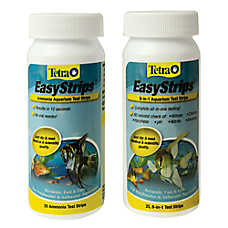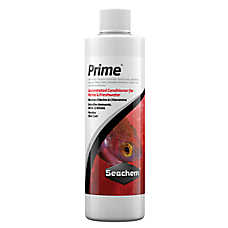Healthy Aquarium Water

In this Article
Your aquarium’s environment
An aquarium is a delicately balanced ecosystem that relies on “good” bacteria to consume and convert the toxic chemicals produced by aquatic animals into less toxic chemicals that are safer and can be removed through regular aquarium maintenance.
When you first set up your aquarium, you’ll need to encourage the growth of these good bacteria. The process, called cycling, can take 3 to 7 weeks. Using bacteria starters can reduce the cycling time to 1 to 3 weeks. Here’s how to start:
- Set up and fill the aquarium with water. Do not add fish. Run the aquarium filter for at least 24 hours to ensure that all equipment is functioning properly and that the ideal temperature is reached.
- Introduce a few small, hardy fish such as danios or livebearers. The number of fish will depend on the size of the aquarium; ask a PetSmart associate for advice.
- Over time, the beneficial bacteria should kick in and balance the chemistry in the aquarium. Once the water is ready, you can slowly introduce new fish.
How do I care for aquarium water?
Daily
- Be sure to check the water temperature in your tank every day.
Weekly
- Replace 25-30% of the tank with clean water
- Test the water's pH, ammonia, nitrite, nitrate, hardness, alkalinity and chlorine
Monthly
- Vacuum aquarium gravel
- Inspect filter; rinse or replace the cartridge, carbon and pre-filter if necessary
- Clean away any algae
- Remove and clean plastic plants and decorative items
- Prune live plants if necessary
What chemicals are in aquarium water?
pH levels
- Normal pH range: 6.5 to 8.2
- PH is the measure of how acidic or basic a solution is.
- Generally, you do not need to worry about pH levels unless your pH levels are dangerously high or low. Most fish can live in a wide range of pH.
- If you have elevated levels of ammonia in your aquarium. it will be more toxic if the pH is higher.
Chlorine and Chloramine
- Normal results: 0.0 mg/L
- Incoming tap water has chlorine or chloramine added to make it safe to drink. These are toxic to fish.
- Any time tap water is added to the aquarium, a water conditioner must be used to remove any chlorine/chloramine that is present.
Ammonia
- Normal results: 0.0 ppm (mg/L)
- Ammonia (NH3) is toxic to fish. It is excreted through the gill membranes of fish, introducing nitrogen into the aquarium.
- Ammonia will be converted into nitrite by “good” bacteria.
Nitrite
- Normal results: 0.0 ppm (mg/L)
- Nitrite (N02) is also toxic to fish. It results from some non-fish waste decomposition (such as uneaten fish food) and natural ammonia oxidation by "good" bacteria.
Nitrate
- Normal range: 0 to 30 mg/L
- Nitrate (N03) is less toxic, but high concentrations for extended periods of time can harm fish. It is the result of natural nitrite oxidation by "good" bacteria.
General Hardness (GH)
- Normal range: 100 to 250 mg/L
- GH is the measure of calcium and magnesium ions in water.
- Low GH is referred to as soft water, high GH is hard water.
- Most fish can live in a wide range of GH, but some species may be more sensitive to changes in GH.
KH, Carbonate Hardness, Alkalinity
- Normal range: 120 to 300 mg/L
- KH, carbonate hardness, is the measure of carbonates and bicarbonates in water.
- Appropriate KH levels will help to stabilize pH levels in the aquarium.
- With regular partial water changes using tap water KH will usually remain at a good level.
Temperature
- Normal range: 74 to 82 degrees Fahrenheit. (23 to 28 C)
- Sudden swings in temperature can harm fish. Use an aquarium heater to keep a consistent temperature.
Ready to find your fish?
We have a wide selection of freshwater fish sold in stores.











